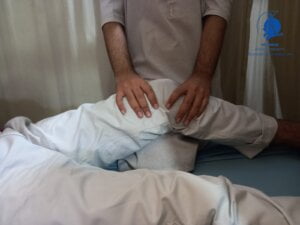The tightness of the capsule in the joint limits the normal movement. It means joint is not able to rolls and glides. In this condition Dr of physiotherapy performs the movement, called joint mobilization.
What is Joint Mobilization?
Joint mobilization is the techniques that physiotherapist are using in our daily practice. It involves passive movement of specific joints using technique, direction and strength expertly. It will help patients in improving joint range of motion and reducing pain.
Grades
There are five grades of joint mobilization
Grade 1 technique is a small amplitude mobilization. It starts at the very beginning of range of motion.
Grade 2 technique is a high amplitude mobilization. It starts at the beginning of range of motion goes through the range but does not reach that restriction.
Grade 3 technique is a high amplitude mobilization. It starts at the beginning of range of motion goes up-to the tissue resistance limit and maintain that movement.
Grade 4 technique is a small amplitude mobilization. It starts at the beginning of range of motion goes through at the end range of the available range of motion.
Grade 5 technique is a high velocity and low amplitude mobilization. It starts at the end range of motion. It is a high velocity and low amplitude thrust, also called as manipulation.
Joint Mobilization Techniques
The Dr of physiotherapy applies pressure on the targeted point of the joint in a specific direction. The level and intensity of pressure depends on the patient response or comfort. It also be perform at a quick speed with short range. You can be heard a sound of pop. It is normally pain free and it helps to improve the mobility of that joint.

Mobilization techniques in physiotherapy
Patients comes with complain of movement restriction in their joint. Physiotherapist is the best person to deal this condition. The most common problems that we are seeing in clinic is frozen shoulder, stiffness in lower back, stiffness in cervical region, stiffness in ankle and foot and many others.
Mobilization and manipulation
Every patient who is facing pain due to joint stiffness can take benefit from mobilization. It is normally not used on those patients who are excessive joint flexibility.
In mobilization, physiotherapist gradually moves the joint to its normal range of motion.
In manipulation, physiotherapist performs instant movement in its normal range of movement. It is a high velocity and low amplitude thrust, which is also known as chiropractic adjustment.
What are the benefits of Joint Mobilization?
Joint mobilization is very helpful in reducing pain. It can also improve the range of motion of your joint. It helps to improve the function of your joint or body such as knee flexion and extension, ankle and foot movement, shoulder movement, neck movement and also bending the spine.
Conclusion
The tightness of the capsule in the joint limits the rolls and glides of the joint. Joint mobilization is the techniques that physiotherapist performs of a specific joint by using their hands. Physiotherapist is the best person to perform the mobilization. Joint mobilization helps patients in reducing pain and achieving normal range of motion.


